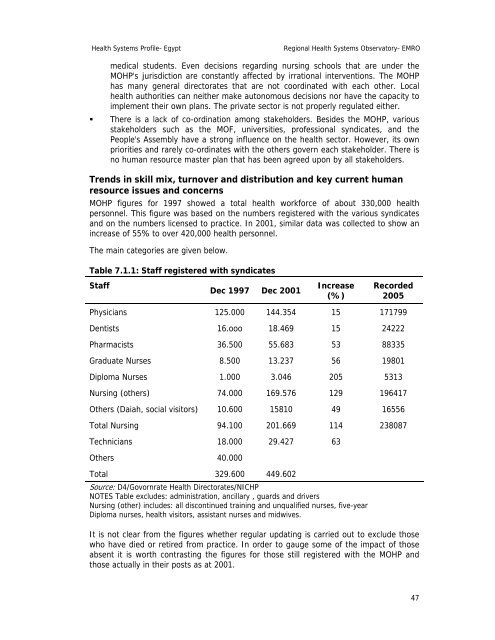Egypt : Complete Profile - What is GIS - World Health Organization
Egypt : Complete Profile - What is GIS - World Health Organization
Egypt : Complete Profile - What is GIS - World Health Organization
Create successful ePaper yourself
Turn your PDF publications into a flip-book with our unique Google optimized e-Paper software.
<strong>Health</strong> Systems <strong>Profile</strong>- <strong>Egypt</strong> Regional <strong>Health</strong> Systems Observatory- EMRO<br />
medical students. Even dec<strong>is</strong>ions regarding nursing schools that are under the<br />
MOHP's jur<strong>is</strong>diction are constantly affected by irrational interventions. The MOHP<br />
has many general directorates that are not coordinated with each other. Local<br />
health authorities can neither make autonomous dec<strong>is</strong>ions nor have the capacity to<br />
implement their own plans. The private sector <strong>is</strong> not properly regulated either.<br />
There <strong>is</strong> a lack of co-ordination among stakeholders. Besides the MOHP, various<br />
stakeholders such as the MOF, universities, professional syndicates, and the<br />
People's Assembly have a strong influence on the health sector. However, its own<br />
priorities and rarely co-ordinates with the others govern each stakeholder. There <strong>is</strong><br />
no human resource master plan that has been agreed upon by all stakeholders.<br />
Trends in skill mix, turnover and d<strong>is</strong>tribution and key current human<br />
resource <strong>is</strong>sues and concerns<br />
MOHP figures for 1997 showed a total health workforce of about 330,000 health<br />
personnel. Th<strong>is</strong> figure was based on the numbers reg<strong>is</strong>tered with the various syndicates<br />
and on the numbers licensed to practice. In 2001, similar data was collected to show an<br />
increase of 55% to over 420,000 health personnel.<br />
The main categories are given below.<br />
Table 7.1.1: Staff reg<strong>is</strong>tered with syndicates<br />
Staff<br />
Dec 1997 Dec 2001<br />
Increase<br />
(%)<br />
Recorded<br />
2005<br />
Physicians 125.000 144.354 15 171799<br />
Dent<strong>is</strong>ts 16.ooo 18.469 15 24222<br />
Pharmac<strong>is</strong>ts 36.500 55.683 53 88335<br />
Graduate Nurses 8.500 13.237 56 19801<br />
Diploma Nurses 1.000 3.046 205 5313<br />
Nursing (others) 74.000 169.576 129 196417<br />
Others (Daiah, social v<strong>is</strong>itors) 10.600 15810 49 16556<br />
Total Nursing 94.100 201.669 114 238087<br />
Technicians 18.000 29.427 63<br />
Others 40.000<br />
Total 329.600 449.602<br />
Source: D4/Govornrate <strong>Health</strong> Directorates/NICHP<br />
NOTES Table excludes: admin<strong>is</strong>tration, ancillary , guards and drivers<br />
Nursing (other) includes: all d<strong>is</strong>continued training and unqualified nurses, five-year<br />
Diploma nurses, health v<strong>is</strong>itors, ass<strong>is</strong>tant nurses and midwives.<br />
It <strong>is</strong> not clear from the figures whether regular updating <strong>is</strong> carried out to exclude those<br />
who have died or retired from practice. In order to gauge some of the impact of those<br />
absent it <strong>is</strong> worth contrasting the figures for those still reg<strong>is</strong>tered with the MOHP and<br />
those actually in their posts as at 2001.<br />
47

















